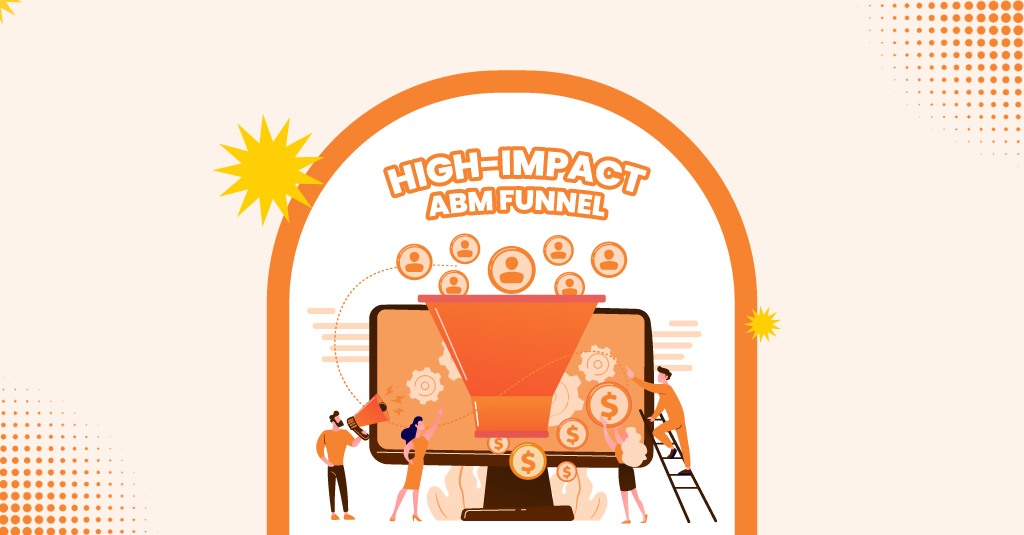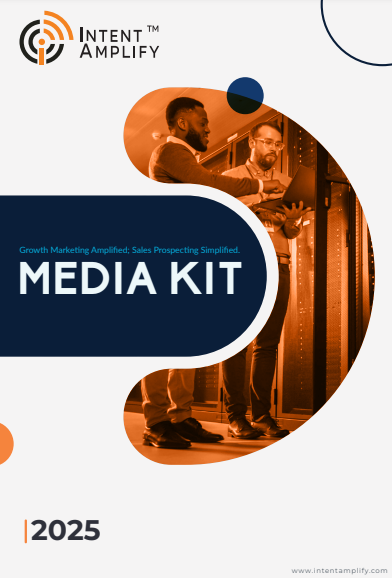
How to build a High-Impact ABM Funnel for B2B in 2025
- Last updated on: July 16, 2025
What if your funnel began with the accounts most likely to purchase? What if your marketing and sales team marched in harmony, fueling customized conversations with actual decision-makers, not indiscriminate leads?
In 2025, it’s achievable with Account-Based Marketing (ABM), and it’s how today’s B2B teams are overcoming buyer fatigue and converting interest into revenue. Because let’s face it: the old funnel was designed for a bygone era. Today, your buyers research, skip cold emails, and demand relevance at every turn.
That’s precisely what an ABM funnel provides. Pure precision, personalization, and performance. And the beauty of it? You don’t require a huge budget or tech stack to create it – you simply need the right strategy. So, let’s reimagine how your funnel operates and how to construct a high-impact ABM engine that gets results in today’s B2B world.
What Is an Account-Based Marketing Funnel?
Intent Amplify defines account-based marketing (ABM) funnel as a very targeted approach that focuses on individual high-value accounts rather than spreading the net wide to catch generic leads. It is like turning the conventional funnel upside down. Instead of beginning with dozens of anonymous prospects, you start with a carefully curated list of firms that fit your ideal customer profile very tightly. Next, you connect with them through tailored, multi-touch campaigns addressing their pain points, decision-making responsibilities, and purchasing journey.
In an ABM funnel, each stage from awareness to conversion to expansion is designed with that specific account in mind. You’re not looking to fill the top of the funnel with as many names as possible. Instead, you’re working with purpose. The goal is clear: create meaningful relationships, accelerate deal velocity, and drive lifetime value. It’s not about quantity. It’s about quality, coordination, and revenue impact.
What Does an ABM Funnel Look Like?
The ABM funnel doesn’t look like the linear, one-size-fits-all models most marketers are accustomed to. It’s instead a dynamic, tiered architecture based on account engagement and intent signals. At the beginning, you have account research and identification. This phase is concerned with choosing the right targets based on firmographic, technographic, and behavioral data.
Then there is the orchestration process: deploying custom-built campaigns through email, social media, direct mail, and events, all in response to the buying committee’s requirements. Mid-funnel, your sales and marketing organizations collaborate to cultivate the relationship through one-to-one communication, value-based content, and decision-stage assets.
At the bottom of the funnel, deal expansion and acceleration are your focus. You’re not only selling, you’re launching a long-term relationship. As opposed to classic funnels that culminate at conversion, the ABM funnel cycles back into upsell, cross-sell, and advocacy. It’s an adaptive system that changes with every account.
Characteristics of an ABM Funnel
What distinguishes an ABM funnel? It’s purposeful, data-driven and designed for team collaboration. To begin, it begins with a clear, high-value account focus. Each step from discovery to renewal is designed specifically for those accounts. You’re not speculating on what they need; you’re leveraging intent data, behavior signals, and direct feedback to inform your messaging.
Second, the ABM funnel lives on personalization at scale. You’re not just personalizing emails or ads but entire role-, industry-, and stage-based buyer journeys. Sales and marketing aren’t working in silos – they’re on the same page with messaging, metrics, and movement.
Lastly, measurement in an ABM funnel goes beyond clicks. You’re tracking engagement depth, pipeline influence, and revenue impact. It’s a smarter, more accountable way to drive growth. The ABM funnel is less about volume and more about precision, progress, and pipeline velocity.
Rethinking the ABM Funnel in 2025
The ABM funnel is not an inverted version of the classic one. It’s a different mentality altogether. Rather than throwing out a broad net and praying for a handful of qualified leads, you’re beginning with a short list of high-value targets.
These are accounts you need to win. And your funnel is designed to help them progress from awareness, engagement, and evaluation to, if you do it correctly, loyalty and expansion.
Forget vanity metrics. No more fixation on CTRs or MQLs. On an ABM funnel, you don’t just want to see movement: Are your target accounts advancing? Are they expressing intent? Are they communicating with your sales team? That’s the funnel you want to create.
Why This Strategy Works Better Than Ever?
Buyers are smarter, quicker, and more autonomous in 2025. They do their research. They’ve established opinions prior to your SDR even dialing. That’s why ABM is taking off. It meets buyers where they are, not where your funnel indicates that they ought to be. It allows you:
- To target high-fit, high-intent accounts
- To personalize messaging by persona and pain point
- To align efforts across marketing, sales, and success
It’s scalable. It’s efficient. And when executed correctly, it’s a revenue machine.
Steps to Build a High-Impact ABM Funnel
Step 1: Identify and Prioritize the Right Accounts
Start with your Ideal Customer Profile (ICP). Who are your best-fit customers? What makes them tick? Dig into firmographics, technographics, behavior, and triggers.
Then segment your list:
- Tier 1: Your dream clients’ custom campaigns all the way
- Tier 2: High-fit accounts with scalable personalization
- Tier 3: Broader targets for nurturing and retargeting
Use data platforms like Bombora or Clearbit to validate and score accounts based on fit + intent. The more precise you are here, the better your funnel performs.
Also consider business maturity, potential deal size, competitor relationships, and account readiness. Account prioritization isn’t a one-time task; update it quarterly as markets shift. Bring sales and marketing together to vet the list and build consensus. This collaborative input ensures that both teams stay focused on the same targets, reducing misalignment and wasted spend.
Step 2: Align Sales, Marketing, and Revenue Ops
ABM isn’t marketing’s solo mission. You need a united front. Marketing creates awareness and engagement. Sales builds relationships and closes deals. RevOps tracks the journey and ensures everything flows.
Set up:
- Shared goals and KPIs
- Regular account check-ins
- Joint planning for outreach and engagement
When these teams speak the same language, your funnel becomes seamless.
Hold recurring meetings to assess account progress, discuss campaign feedback, and refine targeting. Set up shared dashboards to monitor key metrics. Define SLAs between teams to ensure timely follow-ups. Make sure RevOps acts as the connective tissue – standardizing data, enabling handoffs, and resolving friction.
True ABM alignment isn’t about departments cooperating on paper. It’s about shared accountability for revenue. That alignment translates directly into pipeline velocity.
Step 3: Personalize by Role and Stage
This is where most ABM efforts fail. Personalization doesn’t mean “Hi {First Name}.” It means delivering the right message to the right person at the right time. A CFO doesn’t care about product features. They want ROI. Your end user wants ease of use. Your IT lead needs integration details.
So build:
- Persona-specific messaging
- Stage-specific content (awareness, evaluation, decision)
- Multi-channel journeys that feel seamless
The deeper the personalization, the faster accounts move. You should also create content formats tailored to preferences: busy executives may prefer short videos or one-pagers; analysts might want deep-dive guides or product sheets. Use dynamic landing pages and email sequences that adapt by funnel stage.
Map out buyer journeys for each persona across different channels. ABM content should evolve with the relationship, from education to evaluation to trust-building.
Step 4: Use Intent Data and Real-Time Signals
Intent is the secret weapon. When you know who’s researching what, you can show up before your competitors even know what’s happening.
Track:
- What content accounts are consuming
- Which pages do they visit on your site
- Engagement with your emails, ads, and events
Then act on it. Trigger outreach. Launch a retargeting campaign. Send a personalized message from your AE. This is where strategy turns into momentum.
Use third-party tools like 6sense, Bombora, or Demandbase to layer on intent scoring. Combine with first-party behavior like product demo clicks or webinar sign-ups. Use account scoring models to trigger workflows. Send alerts to sales when engagement peaks. Real-time signals should inform every touchpoint from the subject line in your next email to the theme of your next webinar invite.
Step 5: Drive Engagement, Not Just Content
Stop publishing content and hoping someone reads it. Start building experiences that pull people in. Think:
- Interactive content (ROI calculators, quizzes)
- Targeted ads and LinkedIn posts
- Direct mail that makes an impression
- Events and roundtables for decision-makers
Your funnel should feel like a two-way conversation, not a broadcast. Also include experiential formats like virtual briefings, executive dinners, or video Q&As. Let your content address emotional as well as functional triggers. Make every asset clickable, trackable, and feedback-driven.
Remember, it’s not just about capturing attention. It’s about building trust and moving conversations forward. Use engagement signals as fuel to deepen personalization and fine-tune messaging in real time.
Step 6: Measure What Matters
You can’t improve what you don’t measure. But in ABM, metrics look different. Track:
- Account Engagement Score: who’s interacting and how often
- Pipeline Influence: what deals your campaigns are accelerating
- Deal Velocity: How fast accounts move from interest to decision
- Expansion: upsell and cross-sell opportunities
These KPIs tell the real story, not just clicks and views. Make sure your metrics align with business outcomes, not vanity. Build dashboards that show how ABM is influencing revenue at each stage. Use attribution models that connect marketing campaigns to closed deals.
Get qualitative too collect feedback from sales on content relevance and campaign timing. Use that feedback to iterate and improve. ABM measurement isn’t about more data. It’s about better decisions.
Step 7: Orchestrate at Scale
You can’t do this all manually. The best ABM funnels are powered by tools and playbooks. Use:
- Automation for nurture sequences
- CRM integrations to sync data
- ABM platforms to run multi-channel plays
And don’t forget to document your workflows. You want consistency across accounts, teams, and campaigns. Standardize playbooks based on account tiers. Build sequences triggered by engagement thresholds. Use AI tools to personalize outreach at scale without sounding robotic.
Also invest in enablement: give your team training, templates, and tech that make execution frictionless. Use performance data to refine your orchestration over time. Scalable orchestration isn’t about doing more. It’s about doing smarter.
What Makes a High-Impact ABM Funnel in Practice
Building an ABM funnel is easy on slides, but tough in execution. So what separates a basic funnel from a high-impact one? It’s not more tools or bigger budgets. It’s clarity, cohesion, and continuous motion.
Here’s what high-performing ABM funnels get right:
- Clarity: Every team knows the ICP, goals, and messaging strategy.
- Collaboration: Marketing, sales, and RevOps plan together and execute as one.
- Consistency: From outreach emails to landing pages, every touchpoint reflects the same narrative.
- Momentum: Teams act fast on buying signals, not next quarter, now.
- Learning loops: The funnel evolves based on what works, not assumptions.
You don’t need to copy a big brand’s ABM playbook. You just need to build one that works for you. That’s the real high-impact move.
Why Intent Amplify Is Your Strategic ABM Partner
If building a high-impact ABM funnel in 2025 feels overwhelming, you’re not alone. Many B2B teams know the strategy but struggle with execution. That’s where Intent Amplify steps in. We don’t just consult, we collaborate. We help you zero in on the right accounts, activate data-driven engagement, and build a scalable funnel that brings marketing, sales, and RevOps into perfect alignment.
Whether you need help with intent data, personalization workflows, or multi-channel orchestration, our team brings battle-tested frameworks to the table. We’ve helped fast-growing startups and enterprise players drive real pipeline and revenue, without wasting time on the wrong tactics. Let’s co-build your ABM engine. Because when your funnel works, your whole GTM strategy lifts.
FAQs
Q1: What’s the biggest difference between ABM and traditional funnels?
ABM starts with known high-value accounts, not anonymous leads. It’s about targeted engagement over broad outreach.
Q2: How do I choose which accounts to target?
Use a mix of firmographic data, historical win patterns, and real-time intent signals.
Q3: What tools do I need for an ABM funnel?
Look at platforms like HubSpot, Terminus, 6sense, and Bombora. But strategy always comes before tools.
Q4: Can ABM work for smaller B2B companies?
Absolutely. Start small with Tier 1 accounts and expand as you grow.
Q5: How long does it take to see results?
Many teams see early engagement in weeks and pipeline growth within 2–3 months if the funnel is set up correctly.






